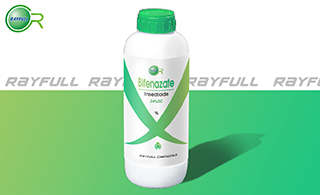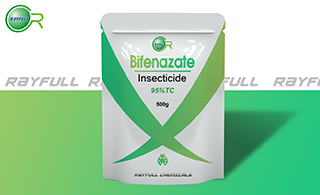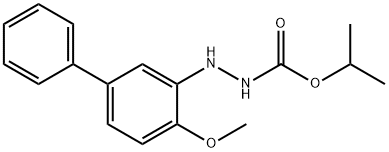Bifenazate
    联苯肼酯 联苯肼酯
Introduction: Bifenazate Miticide Insecticides provide outstanding control of a variety of mite pests on plants in greenhouse, shadehouses, nursery, field, landscape and Interiorscape settings. Bifenazate is effective on a variety of mites and all life stages of Tetranychid spider mites. Bifenazate produces quick knockdown through contact activity and long residual control of more than 28 days. Bifenazate is easy on predacious mites and beneficial insects, making it ideal forof use in IPM and resistance management programs. Bifenazate has a unique mode of action as a member of the Carbazates class of chemistry. Floramite SC is a fast-acting, broad-spectrum miticide. Bifenazate is effective on a wide range of mites and all life stages of Tetranychid spider mites.
Common name: Bifenazate
Another name: Floramite; Bifenazate [ISO]; Isopropyl 2-(4-methoxy-[1,1'- biphenyl]-3-yl)hydrazinecarboxylate; UNII-24Z9QW0505; etc.
Chemical name: isopropyl 3-(4-methoxybiphenyl-3-yl)carbazate
Empirical formula: C17H20N2O3
Structural formula:

Mol. Weight: 300.35g/mol
CAS No.: 149877-41-8
Specifications
Leading Bifenazate supplier
Bifenazate 95% TC
Bifenazate 24% SC
Packing:
BULK PACKING
Powder: 25kg/Bag, 25kg/Drum, 50kg/Drum etc.
Liquid: 200L/Drum, 20L/Drum, 10L/Drum etc.
SMALL PACKING
Powder: 1kg/Alu bag, 500g/Alu bag, 200g/Alu bag, 100g/Alu bag, 50g/Alu bag, 15g/Alu bag etc.
Liquid: 5L/Drum, 1L/Bottle, 500ml/Bottle, 250ml/Bottle, 100ml/Bottle, 50ml/Bottle etc.
Customerized packing label
Bifenazate FAO standard
Professional registration
HAZARDS IDENTIFICATION
Hazard statement(s)
H317 (97.56%): May cause an allergic skin reaction.
H319 (56.1%): Causes serious eye irritation.
H373 (41.46%): Causes damage to organs through prolonged or repeated exposure.
H400 (100%): Very toxic to aquatic life.
H410 (41.46%): Very toxic to aquatic life with long lasting effects.
Precautionary statement(s)
P261: Avoid breathing dust/fume/gas/mist/vapors/spray.
P264: Wash ... thoroughly after handling.
P272: Contaminated work clothing should not be allowed out of the workplace.
P273: Avoid release to the environment.
P302+P352: IF ON SKIN: wash with plenty of water.
P305+P351+P338: IF IN EYES: Rinse cautiously with water for several minutes. Remove contact lenses if present and easy to do - continue rinsing.
P314: Get medical advice/attention if you feel unwell.
P321: Specific treatment (see ... on this label).
P333+P313: IF SKIN irritation or rash occurs: Get medical advice/attention.
P363: Wash contaminated clothing before reuse.
P391: Collect spillage.
P501: Dispose of contents/container to.
Supplemental Hazard Statements: none.
MAMMALIAN TOXICOLOGY
Acute toxicity: 1) Acute oral LD50 for rats is >5000 mg/kg. 2) Acute dermal LD50 for rats is >5000 mg/kg. 3) Acute inhalation toxicity LC50 (4 h) for rats is>4.4 mg/L. 4) Skin irritation: Slightly irritating to skin (rabbits). 5) Eye irritation: Slightly irritating to eyes (rabbits). 6) Skin sensitization for guinea pig: Non-sensitizer.
NOEL: (2 y) for rats is 3.9 mg/kg/day, (79 w) for mice is 1.5 mg/kg/day, (90 d) for dogs is 0.9 mg/kg/day. Other Not carcinogenic. Not genotoxic.
ADI (JMPR) 0-0.01 mg/kg b.w. [2006]
Classification:
WHO Classification: U (Unlikely to present an acute hazard)
EC Risk Classification: Xn - Harmful: R43; Xi - Irritant: R36
US EPA Classification (formulation): III (Caution - Slightly toxic)
ECOTOXICOLOGY
Effect on birds: Acute feeding LD50 (8 d) for Bobwhite quail is 1036 mg/kg. Effect on fish: Acute LC50 (96 h) for Bluegill sunfish is 0.58 mg/l. Effects on aquatic invertebrates: Acute EC50 (48 h) for Daphnia magna is 0.5 mg/l. Effects on algae: Acute 72 hour EC50 for Skeletonema costatum is 0.3 mg/l. Effects on bees: Contact acute 48 hour LD50 is >8.5 μg/bee, oral acute 48 hour LD50 is >98.0 μg/bee. Effects on earthworms: Acute 14 day LC50 is >429 mg/kg.
ENVIRONMENTAL FATE
Animals In animals, the product is considered to be of poor bioavailability, and most of the dose is excreted in the faeces. Absorption is dose dependent (80-85% at 10 mg/kg, 22-29% at 1000 mg/kg). The absorbed dose undergoes oxidation to the corresponding azo compound, and hydroxylation; hydroxylated metabolites appear in the urine as sulfate or glucuronide conjugates. Plants Considered to be non-systemic; most residues stay on the surface and peel of the crops, where it is mostly not metabolised. Traces that penetrated the peel were metabolised as for animals. Soil/Environment DT50 in aerobic soil c. 7 h; DT50 (anaerobic) c. <1 d. Neither bifenazate nor its degradation products leached in a variety of soil types; Koc (by hplc) 1778. DT50 in natural water 45 min.; DT50 for field dissipation 5 d.
Usage: Bifenazate was discovered by Uniroyal Chemical Co., Inc. (now part of Crompton Corp.). Developed jointly by Uniroyal and Nissan Chemical and first marketed in 2000. It is an effective, new pesticide for phytophagous mite control.
Application: Mode of action Non-systemic acaricide with predominantly contact action and long residual action. Uses Under development by Crompton Corp. for control of phytophagous mites (both eggs and motile stages) on crops including citrus, tree fruits, vines, hops, nuts, vegetables, ornamentals, cotton and maize. Proposed use rates are 0.15-0.75 kg/ha.
| 






